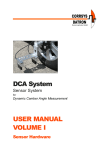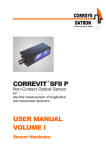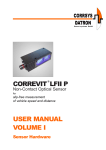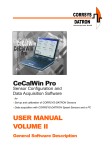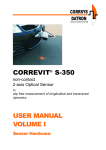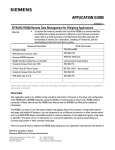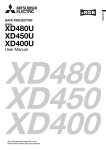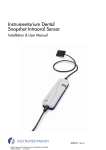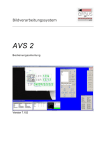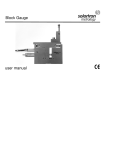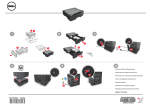Download USER MANUAL
Transcript
WPT Incremental Wheel Pulse Transducer for acquisition of wheel rotation data USER MANUAL User Manual Wheel Pulse Transducer Notes: © 2008 CORRSYS-DATRON Sensorsysteme GmbH, Wetzlar WPT_m-006-e-rev001 10/08 2 User Manual Wheel Pulse Transducer Contents General Information . . . . . . . . . . . . . . . . . . . . . . . . . . . . . . . . . . . . . . . . . . . . . . . . . . . . . .4 Safety Instructions . . . . . . . . . . . . . . . . . . . . . . . . . . . . . . . . . . . . . . . . . . . . . . . . . . . . . . .5 1. Overview . . . . . . . . . . . . . . . . . . . . . . . . . . . . . . . . . . . . . . . . . . . . . . . . . . . . . . . . . . .6 2. Extent of Delivery . . . . . . . . . . . . . . . . . . . . . . . . . . . . . . . . . . . . . . . . . . . . . . . . . . .8 3. Technical Data . . . . . . . . . . . . . . . . . . . . . . . . . . . . . . . . . . . . . . . . . . . . . . . . . . . . . .9 3.1 Specifications . . . . . . . . . . . . . . . . . . . . . . . . . . . . . . . . . . . . . . . . . . . . . . . . . . . .9 3.2 Pin Assignments . . . . . . . . . . . . . . . . . . . . . . . . . . . . . . . . . . . . . . . . . . . . . . . . .10 3.2.1 Pin assignment: 12-pin M23 flange plug . . . . . . . . . . . . . . . . . . . . . . . . . . 10 3.2.2 Pin assignment: 8 pin M12 plug . . . . . . . . . . . . . . . . . . . . . . . . . . . . . . . . . 10 3.2.3 Pin assignment: 9-pin D-Sub socket . . . . . . . . . . . . . . . . . . . . . . . . . . . . . 11 3.2.4 Pin assignment: 3-pin Lemo . . . . . . . . . . . . . . . . . . . . . . . . . . . . . . . . . . . 11 4. 5. Mounting and Connection . . . . . . . . . . . . . . . . . . . . . . . . . . . . . . . . . . . . . . . . . . .12 4.1 Mounting Options . . . . . . . . . . . . . . . . . . . . . . . . . . . . . . . . . . . . . . . . . . . . . . .12 4.2 Mounting Instructions . . . . . . . . . . . . . . . . . . . . . . . . . . . . . . . . . . . . . . . . . . . . .12 4.3 Connecting the sensor . . . . . . . . . . . . . . . . . . . . . . . . . . . . . . . . . . . . . . . . . . . .17 Troubleshooting . . . . . . . . . . . . . . . . . . . . . . . . . . . . . . . . . . . . . . . . . . . . . . . . . . . .18 In a continuous effort to improve our products CORRSYS-DATRON reserves the right to change specifications without prior notice. © 2008 CORRSYS-DATRON Sensorsysteme GmbH, Wetzlar WPT_m-006-e-rev001 10/08 3 User Manual Wheel Pulse Transducer General Information Legal Notice Information furnished is believed to be accurate and reliable. However, CORRSYS-DATRON assumes no responsibility for the consequences of use of such information nor for any infringement of patents or other rights of third parties which may result from its use. No license is granted by implication or otherwise under any patent or patent rights of CORRSYS-DATRON. Specifications mentioned in this publication are subject to change without notice and do not represent a commitment on the part of CORRSYS-DATRON. This publication supersedes and replaces all information previously supplied. All brand names are trademarks of their respective holders. Copyright Notice ©Copyright 2008, CORRSYS-DATRON Revision WPT_m-006-e-rev001 10/08 Contact International Headquarters: CORRSYS-DATRON Sensorsysteme GmbH Charlotte-Bamberg-Str. 12 35523 Wetzlar / Germany Phone ++49 (6441) 9282-0 Hotline ++49 (6441) 9282-82 Fax ++49 (6441) 9282-17 E-mail [email protected] URL www.corrsys-datron.com North American Headquarters: CORRSYS-DATRON Sensorsystems, Inc. 40000 Grand River, Suite 503 Novi, MI 48375 / USA Phone ++1 (248) 615-2035 Toll-free++1 (800) 832-0732 Fax ++1 (248) 615-2184 E-mail [email protected] URL www.corrsys-datron.com China Headquarters: CORRSYS-DATRON Sensorsysteme GmbH, China Office Room 708, JinTianDi International Mansion, No. 998 RenMin Road, Shanghai (200021), P.R.China Tel.: ++86-21-63114144 Fax: ++86-21-63114154 E-mail: [email protected] URL: www.corrsys-datron.com.cn © 2008 CORRSYS-DATRON Sensorsysteme GmbH, Wetzlar WPT_m-006-e-rev001 10/08 4 User Manual Wheel Pulse Transducer Safety Instructions Please read carefully before operating the equipment. CORRSYS-DATRON is not responsible for damage that may occur when this system is used in any way other than that for which it is intended. To assure safe and proper operation, all supplied equipment, components and/or accessories must be carefully transported and stored, as well as professionally installed and operated. Careful maintenance and usage in full accordance with operating instructions is imperative. CORRSYS-DATRON equipment should be installed and operated only by qualified persons who are familiar with devices of this type. Local regulations may not permit the operation of motor vehicles on public highways while the equipment is mounted on the exterior of the vehicle. • Use the equipment only for intended applications. Improper application is not advised. • Do not modify or change the equipment or its accessories in any way. • Improper use or mounting of the equipment may affect the safety of the vehicle and/or occupants. • The equipment must not be mounted and/or operated in any way that may compromise vehicle and/or occupant safety. • Equipment must be mounted firmly and securely. • Use only original equipment, components and/or accessories included in the scope of delivery. • Do not use defective or damaged equipment, components and/or accessories . • Always note correct pin assignments and operating voltages when connecting equipment to power supplies, data acquisition/evaluation systems, and/or any other applicable system or component. Equipment may be damaged if not properly connected and/or operated. • For additional information, please call the CORRSYS-DATRON Hotline: ++49 (6441) 9282-82 or: [email protected] • The sensor must be mounted with the care and accuracy that precision testing equipment requires. Warning • Due to design, axial load exceeding 20 N will damage the sensor! • Due to design radial load exceeding 40 N will damage the sensor! • DO NOT clean any sensor component with steam! © 2008 CORRSYS-DATRON Sensorsysteme GmbH, Wetzlar WPT_m-006-e-rev001 10/08 5 User Manual Wheel Pulse Transducer 1. Overview WPT Incremental Wheel Pulse Transducer for Acquisition of Wheel Rotation and Calculation of: • Wheel Speed • Distance Travelled • Vehicle Speed Art.no. Wheel Incremental Transducer 11355 The CORRSYS-DATRON Wheel Pulse Transducer is a universally adaptable measuring unit for the acquisition data derived from vehicle wheel rotation. The WPT delivers 1000 pulses per rotation (standard, other values are possible*). Available signals with cable version “open end”: A, A inverted, B, B inverted, Z, Z inverted (0 impulse). Available signals with cable version “D-Sub 9”: A. The WPT Wheel Pulse Transducer is ultra-compact and extremely light in weight. For maximum flexibility, the incremental transducer unit of the WPT can be exchanged quickly and easily. Output signals generated by the WPT provide the basis from which wheel rotation speed, acceleration, distance and speed are calculated. * on request © 2008 CORRSYS-DATRON Sensorsysteme GmbH, Wetzlar WPT_m-006-e-rev001 10/08 6 User Manual Wheel Pulse Transducer Application The CORRSYS-DATRON Wheel Pulse Transducer is a universally adaptable measuring unit for the acquisition of wheel rotation on vehicles and is applicable to these and other measurement applications: • Acquisition of wheel rotation speed, distance and wheel speed • Wheel slip measurement on passenger cars • Acceleration and braking tests (pay attention to wheel slip) • ABS testing • Measurement of the difference between wheel speeds (e.g. testing of all-wheel drive vehicles) • Special configurations available for trucks and busses © 2008 CORRSYS-DATRON Sensorsysteme GmbH, Wetzlar WPT_m-006-e-rev001 10/08 7 User Manual Wheel Pulse Transducer 2. Extent of Delivery 7 8 5 1 6 4 3 2 Standard Delivery: 11355 Wheel Incremental Transducer without mounting collets Pos. 1. 2. 3. 4. 5. 6. 7. 8. Art. no. 14865 14921 11968 11281 11291 15176 15178 15181 Description Transducer, 5-30V, 1000P IP67, 8 pin. Signal cable, 5m 8P for WPT 5-30V 9P SUB-D Mounting hardware Open-ended wrench 10-13 Nut driver, hexagon Transport case, 545x405x120mm Foam insert for transport case Foam insert for WPT transport case Options / Accessories • 10070 • 10071 • 10072 Mounting collets, 17 mm (standard) Mounting collets, 19 mm (standard) Mounting collets, 21 mm (standard) Other sizes available upon request. • • • • 11296 11297 11298 10036 Centering stars, 5-lug Centering stars, 4-lug Centering stars, 3 lug Suction cup for fixing the safety line • • • • 14897 14898 14915 15083 Signal Signal Signal Signal cable cable cable cable 5m 8P WPT IP67 open end 10m 8P WPT IP67 open end 5m 8P WPT 3P Lemo 10m 8P WPT 5-30V 9P SUB-D © 2008 CORRSYS-DATRON Sensorsysteme GmbH, Wetzlar WPT_m-006-e-rev001 10/08 8 User Manual 3. Technical Data 3.1 Specifications Wheel Pulse Transducer Characteristic Mechanical Values Max. permissible rotational speed 6000 min-1 (continuous operation 3000 min-1) Available pulse values Standard: 1000 pulses/rotation, 10 to 3600 pulses/rotation on request System protection IP 67 Operating temperature range -40° C ... +85° C Shock resistance 2500 m/s2, 6 ms Vibration resistance 100 m/s2, 10 ... 2000 Hz Characteristic Electrical Values Output circuit RS-422 (TTL compatible) Push-pull circuit Power supply, UB 5 ... 30 V DC 10 ... 30 V DC Power consumption, signals inverted, without load type 40 mA / max. 90 mA type 50 mA / max. 100 mA Permissible weight/channel max. ±20 mA max. ±20 mA Pulse frequency max. 300 kHz max. 300 kHz Signal level, high min. 2.5 V min. UB - 1V Signal level, low max. 0.5 V max. 0.5 V Rising and falling time max. 200 ns max. 1 μs Reverse polarity protection of the power supply yes yes Short circuit-proof outputs max. 1 channel could be short-circuited yes Output signal 2 channels, A and B, 90° shifted, 1 zero impulse per rotation, all signals with inversion Plugs 12 pin M23 or 8 pin M12 plug radial flange connector on the housing, pins separately sealed, IP 67 in unplugged condition © 2008 CORRSYS-DATRON Sensorsysteme GmbH, Wetzlar WPT_m-006-e-rev001 10/08 9 User Manual 3.1 Wheel Pulse Transducer Pin Assignments 3.2.1 Pin assignment: 12-pin M23 flange male plug - sensor connector WPT Art.no. 14375 Pin Pin Pin Pin Pin Pin Pin Pin 1 2 3 4 5 6 7 Signal Pin Signal Signal B inverted +UB Sensor * Zero pulse Zero pulse inverted Signal A Signal A inverted n.c. Pin 8 Pin 9 Pin 10 Pin 11 Pin 12 Shield Signal B n.c. 0 V (GND) 0 V Sensor * +UB on the housing * Sensor leads are internally connected to the power supply and can be used with extension cables for power adjustment or regulation of the transducer. If sensor leads are not used, they must either be isolated or connected 0 V Sensor with 0V and UB Sensor with UB. On type RS 422 the lead end must be covered with a corresponding shaft resistor when extension cables are used. Unused outputs must be isolated prior initial operation. Cables: A. Signal Cable K-006-130-20-5m female B. Signal Cable K-006-130-10-5m female 9 pin D-Sub Part.no. 10465 A. Power supply UB = 5 VDC 9 pin D-Sub Part.no. 10464 B. Power supply UB = 10 ... 30 VDC Pin Signal Pin Signal Pin 1 Pin 2 Pin 3 Pin 4 Pin 5 Pin 6 Pin 7 Pin 8 Pin 9 Shield 1 kΩ against Pin 5 and Pin 7 each Signal A n.c. n.c. 0V (GND), 1 kΩ against Pin 1 n.c. +UB (5 VDC), 1 kΩ against Pin1 n.c. n.c. on housing Pin 1 Pin 2 Pin 3 Pin 4 Pin 5 Pin 6 Pin 7 Pin 8 Pin 9 Shield Bridge to Pin 7 Signal A n.c. +UB (10 ... 30 VDC), 0V (GND) n.c. Bridge to Pin 1 n.c. n.c. on housing 3 2 3 pin Lemo Part.no. 10466 1 © 2008 CORRSYS-DATRON Sensorsysteme GmbH, Wetzlar C. Signal Cable K006.52.51 Pin Signal Pin 1 Pin 2 Pin 3 Signal A GND +12V WPT_m-006-e-rev001 10/08 10 User Manual Wheel Pulse Transducer 3.2.2 Pin assignment: 8 pin M12 male plug - sensor connector WPT Art.no. 14865 Pin Pin Pin Pin Pin Pin Pin Pin Pin Signal 1 2 3 4 5 6 7 8 GND +UB Signal A Signal A inverted Signal B Signal B inverted 0 imp 0 imp inverted Cables: A. Signal Cable K-006-181-20-5m female 9 pin D-Sub Part.no. 14921 A. Power supply UB = 5 ... 30 VDC Pin Signal Pin 1 Pin 2 Pin 3 Pin 4 Pin 5 Pin 6 Pin 7 Pin 8 Pin 9 Shield Bridge to Pin 7 Signal A n.c. +UB (5 ... 30 VDC), 0V (GND) n.c. Bridge to Pin 1 n.c. n.c. on housing 3 2 B. Signal Cable K-006-181-30-5m 3 pin Lemo Part.no. 14915 1 Pin Signal Pin 1 Pin 2 Pin 3 Signal A GND +12V © 2008 CORRSYS-DATRON Sensorsysteme GmbH, Wetzlar WPT_m-006-e-rev001 10/08 11 User Manual Wheel Pulse Transducer 4. Mounting and Connection 4.1 Mounting Options The Wheel Pulse Transducer mounts to the wheel lug nuts via adjustable mounting collets. The torsional protection rod (which maintains rotation around the wheel axis) is affixed to the vehicle body with suction holders. • Mounting disk: Fits 3-, 4- and 5-lug rims • Mounting collets: Standard: 17, 19, 21 mm (other sizes available upon request) • Centering stars: 3-, 4- and 5-fold star, optional • Torsional mounting: Joints, guide rod, suction holder, gaiter seals 4.2 Mounting Instructions 1. Select the following parts: Mounting collets Retainer screws with washers Nut driver, hexagon Mounting disk Fig. 1 2. Remove hubcap or any covering over wheel nuts and clean dirt/debris from wheel nuts. Remove the retainer screws from the top of each collet, then place the mounting collets firmly on the wheel nuts. Mounting collets Fig. 2 © 2008 CORRSYS-DATRON Sensorsysteme GmbH, Wetzlar WPT_m-006-e-rev001 10/08 12 User Manual Wheel Pulse Transducer 3. Align the mounting disk with the collets and affix it with retainer bolts and washers. Do NOT fully tighten the bolts at this step! NOTE: Each mounting slot on the disk is marked to ensure proper alignment with 3-, 4-, and 5-lug configurations. ATTENTION: The lobe of the washers (Fig.3b) must show towards the collets! Fig. 3b Fig. 3a 4. A rough centering of the mounting plate can be achieved by slight rotation in clockwise direction. Fig. 4 5. If you use centering stars for mounting, select the centering star that corresponds to the lug configuration (3x, 4x, or 5x) of the wheel on which the sensor will be mounted. (Fig. 5 shows 5-fold star) NOTE: Each centering star is fitted with nylon knobs, which facilitate positioning and serve as leverage points. Positioning knobs Fig. 5 6. Slide the centering star onto the mounting disk hub and rotate the centering star so that its edges press firmly against the collet retainer washers. Then, apply pressure to the positioning knobs on the centering star, as shown, and tighten one of the bolts using a 5 mm hex nut driver. This will ensure that the mounting disk is properly centered on the wheel. Fig. 6 © 2008 CORRSYS-DATRON Sensorsysteme GmbH, Wetzlar WPT_m-006-e-rev001 10/08 13 User Manual Wheel Pulse Transducer 7. Continue to hold the centering star tightly against the mounting washers, then tighten the mounting bolts in a cross pattern. The deviation of concentricity should be within 0.2 mm (see page 18, Signal errors due to incorrect mounting). Fig. 7 8. Select the following parts: A. Transducer with mounting plate B. Transducer mounting bolt C. Suction mount D. Torsion mounting assembly E. Extension rod Fig. 8 9. If the transducer mounting plate is not already mounted to the transducer, slide the plate onto the back of the transducer as shown in Fig. 9 and secure it by tightening the set screw. A A. Transducer mounting plate B. Transducer B C C. Set screw Fig. 9 © 2008 CORRSYS-DATRON Sensorsysteme GmbH, Wetzlar WPT_m-006-e-rev001 10/08 14 User Manual Wheel Pulse Transducer 10. Slide the transducer mounting bolt through the hole at the center of the transducer, then thread the bolt into the hole at the center of the mounting hub. Tighten the bolt securely using the knob. Transducer Knob on short mounting bolt Fig. 10 11. Some vehicle body configurations may require the use of the spacer shown in Figure 11a/11b in order to mount the torsion assembly parallel to the vehicle. The spacer is placed between the mounting disk and the transducer. When using the spacer, it is necessary to use the long transducer mounting bolt. Axial load exceeding 20 N / radial load exceeding 40 N will damage the sensor! Danger Long mounting bolt Spacer Fig. 11a ATTENTION: The slot of the spacer must be directed towards the Sensor! spacer slot Fig. 11b 12. Measure or visually estimate the distance from the top of the transducer mounting clamp to an area of the vehicle body onto which the suction holders can be attached. Next, select either or both of the two extension rod sections and configure the assembly to the required length. Each rod has a threaded female end and a threaded male end. This allows the rods to be fitted together, as well as into the main section of the torsion assembly. If multiple sections are required, tighten them together by hand, then slide a small screwdriver (or similar tool of appropriate diameter) into the small holes near the the ends of the extension rods. Using the screwdrivers for leverage, tighten the sections together firmly (use caution to avoid stripping the threads). Then, screw the extension rod(s) into the threaded female receptacle at the top of the mounting plate as shown in Figure 12 and tighten. © 2008 CORRSYS-DATRON Sensorsysteme GmbH, Wetzlar Fig. 12 Extension rod(s) Top of mounting plate WPT_m-006-e-rev001 10/08 15 User Manual Wheel Pulse Transducer 13. Loosen the cap at the bottom end of the gaiter that protects the mounting assembly. Then, slide the gaiter back to enable access to the threaded end of the rod. Protective gaiter Gaiter cap Fig. 13 14. Screw the main section of the torsion assembly into the top of the extension rod(s) and tighten. Slide the protective gaiter back over the threaded joint and re-thread the cap, but do not fully tighten it at this step (see step 17, page 17). Press the suction holders firmly against the vehicle body and latch the suction holder lock handles as shown in Figure 14 (latched position is approximately parallel to vehicle body surface). When the suction holders produce an effective vacuum, you will feel a distinct resistance. Fig. 14 ATTENTION: To assure proper function of the suction holders, the mounting area must be free of grease, oil, dust and other contaminants. For this reason it its necessary to clean the painted surface in the mounting area before attaching the suction holders. Do not use cleaning products that leave residue of any kind on the surface. 15. Plug the signal cable into the transducer and tighten the connector. Fig. 15 © 2008 CORRSYS-DATRON Sensorsysteme GmbH, Wetzlar WPT_m-006-e-rev001 10/08 16 User Manual Wheel Pulse Transducer 16. Wind the signal cable loosely around the torsion rod and secure with a cable tie. WARNING: Be sure to leave enough slack in the cable to allow for suspension travel, but use caution to assure that the cable is Danger not wound too loosely around the torsion bar. Under no circumstances should the cable be loose enough to touch the tire or to be pulled under the fender during testing. Either circumstance would inevitably result in damage to the equipment and could also cause an accident. Fig. 16 17. Slide the protective gaiters over the lower and upper sections of the torsion rod assembly and tighten the caps. Then, secure the safety line to the vehicle. In Figure 17, the safety line is tied to an optional suction cup. Danger B E D C The safety line should always be used to avoid damage or injury in the event that a suction holder separates from the vehicle body during the test drive. A A. Suction cup B. Cap C C. Gaiter D. Safety line E. Optional suction cup B Fig. 17 4.3 Connecting the Sensor Finally, connect the signal cable to data acquisition. When using other than CORRSYS-DATRON data acquisition systems, make sure that the polarity of the sensor supply is correct and the data acquisition supplies the sensor-specific current and signal conditions. © 2007 CORRSYS-DATRON Sensorsysteme GmbH, Wetzlar D006-50-02-04E 06/07 17 User Manual Wheel Pulse Transducer 5. Troubleshooting When troubleshooting the CORRSYS-DATRON Incremental Wheel Pulse Transducer, begin by checking the following: Cables and power supply • Check all connections to determine that each is complete and that the system is connected to a power supply that provides voltage output within the specified range. • Check to determine that the correct cables have been used for all connections. • The following problems can be caused by incorrect or incomplete cable connections and/or connection to incorrect power supply voltage: - A sensor will not show any signal with vehicle motion. Signal errors due to incorrect mounting • Make sure that the sensor is mounted parallel to the wheel. • The deviation of concentricity should be within 0.2 mm (see Step 7 on page 14). • Please see that the torsion mounting assembly is adapted to the vehicle type (suspension travel). • Do not exceed the maximum rotational speed of 3000 RPM or 250 kph. If none of the above recommendations provides a solution, please contact us. CORRSYS-DATRON Hotlines: CORRSYS-DATRON Hotline: ++49 (6441) 9282-82 or: [email protected] CORRSYS-DATRON Servie-Hotline: ++49 (6441) 9282-29 or: [email protected] © 2008 CORRSYS-DATRON Sensorsysteme GmbH, Wetzlar WPT_m-006-e-rev001 10/08 18


















